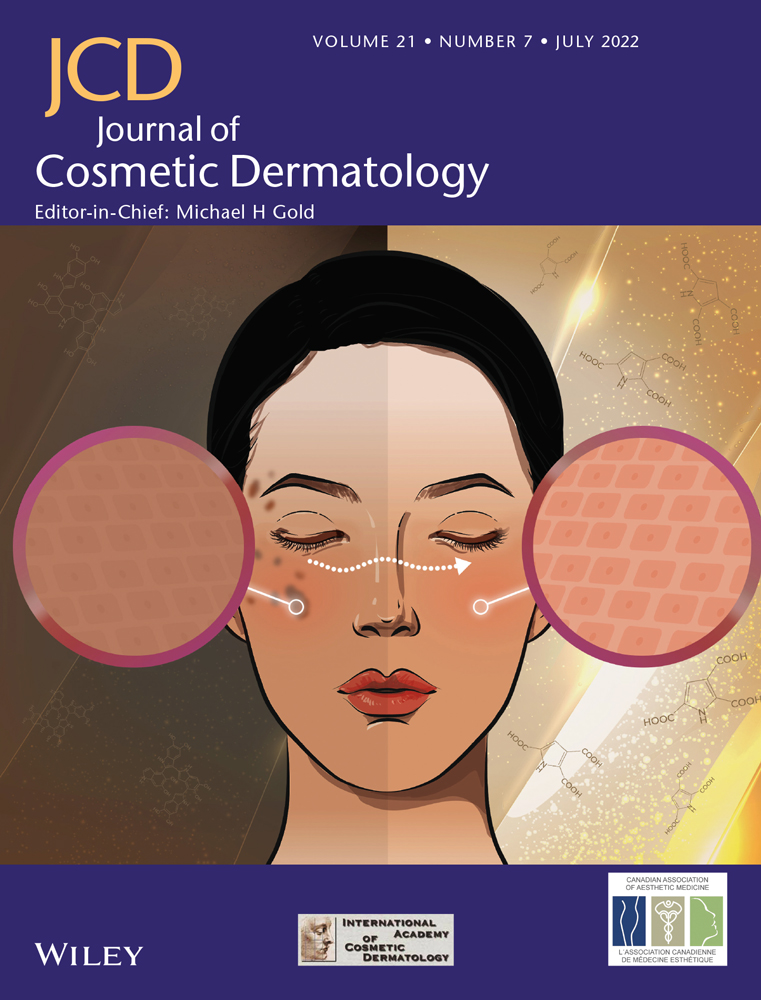Optimal application method of a moisturizer on the basis of skin physiological functions
Funding information
The test products used in this study were provided by Tokiwa Pharmaceutical Co. Ltd.
Abstract
Background
Clinical studies have clarified the usefulness of moisturizers for dry skin diseases. However, few reports exist on the appropriate application of moisturizers with respect to the skin physiological functions.
Aims
To clarify the optimal moisturizer application method on the basis of skin physiological functions.
Methods
This study investigated the appropriate time, dose, and frequency of moisturizer application from the perspective of skin physiology. In healthy subjects, the stratum corneum water content (SCW) was compared between different moisturizer application times (immediately [≤5 min] and 90 min after bathing), doses (0.5, 1.0, and 2.0 mg/cm2), and frequencies (once and twice daily). Thereafter, patients with dry skin were treated with the moisturizer once or twice daily for 8 weeks at the time, and application dose was determined to be optimal for the healthy subjects; the moisturizing effect was evaluated based on the SCW, trypsin activity, and desmoglein 1 localization score in the stratum corneum.
Results
In healthy subjects, compared to at control sites, the SCW was significantly higher at sites treated with the moisturizer immediately after bathing, with 1.0 and 2.0 mg/cm2 of the moisturizer, and with once- and twice-daily applications.
In patients with dry skin, the SCW was significantly higher compared to control sites and the desmoglein 1 localization score was significantly lower after 8 weeks only when the moisturizer was applied twice daily.
Conclusions
Moisturizer application of ≥1.0 mg/cm2 twice daily (immediately after bathing at night and in the morning) had a moisturizing effect, as verified from the skin physiological functions.
1 INTRODUCTION
The skin is a vital organ that forms a protective boundary between the body and the external environment. The stratum corneum, a thin tissue of approximately 20 µm thickness, is the outermost layer of the skin and plays an essential role in maintaining the skin barrier function. The barrier function is important for maintaining life, as it prevents the entry of substances from outside the body and regulates the evaporation of water from within the body. However, external factors (such as dry air and ultraviolet rays) and internal factors (such as aging and stress) disrupt the physiological functions of the stratum corneum and reduce the moisture retention capacity of the skin, rendering it hypersensitive to stimuli.1, 2 When this happens, it is important to avoid dry environments and supplement cutaneous moisture and oils through the application of moisturizers.
The importance of skincare with moisturizers for dry skin-related conditions has gained recognition in recent years. In the case of atopic dermatitis, a typical dry skin disease, the treatment guidelines of the American Academy of Dermatology and the Japanese Dermatological Association clearly state that skincare with moisturizers is a representative treatment.3, 4 Symptomatic treatments are mainly administered for xeroderma and include topical therapy with moisturizers such as petrolatum.5, 6 Numerous clinical studies have been conducted to investigate the effectiveness of moisturizers in patients with atopic dermatitis and xeroderma.7-11 However, there are limited data on the appropriate usage and dosage of the moisturizers currently available, and the optimal methods of moisturizer application to the skin have not been fully clarified in terms of the skin physiology.
Therefore, this study first compared the moisturizing effects between different application times (immediately [≤5 min] and 90 min after bathing), doses (0.5, 1.0, and 2.0 mg/cm2), and frequencies (once and twice daily) in healthy subjects from the perspective of skin physiology. Furthermore, the moisturizer was applied once or twice daily for 8 weeks to patients with dry skin to verify the most appropriate method of application.
2 MATERIALS AND METHODS
2.1 Subjects
2.1.1 Comparison of the moisturizing effects in healthy subjects (Experiment 1)
Eight healthy, randomly selected adult women who regularly applied moisturizers were included in this study.
2.1.2 Comparison of the moisturizing effects in patients with dry skin conditions (Experiment 2)
The subjects were women aged ≥20 years who had dry skin conditions. The exclusion criteria were as follows: (1) presence of a rash at the evaluation site that rendered it unsuitable for test product application, (2) patients who could not be evaluated after 8 weeks from the start of the trial, and (3) patients deemed unsuitable for the trial by the physician in charge. Twenty-four adult women with dry skin diseases (atopic dermatitis: 8, xeroderma: 16) were included in this study. This prospective study was approved by the Hattori Clinic Ethics Review Board (Tokyo, Japan) (N027). All study participants provided informed consent to participate in this study.
2.2 Test period
2.2.1 Experiment 1
Experiment 1 was conducted from November to December 2015; tests for each application method could be initiated on any day within this period.
2.2.2 Experiment 2
Experiment 2 was conducted for 8 weeks from January to March 2016.
2.3 Test product
The moisturizer used in these experiments was the NOV® Oligomarine Lotion S (Noevir Co., Ltd.), which is a lotion-type product commercially available in Japan. It has proven moisturizing effects in patients with dry skin.12 The primary moisturizing ingredients are 1,3-butylene glycol, glycerin, sodium polyaspartate, concentrated seawater, and sodium hyaluronate.
2.4 Method of application and measurement procedure
2.4.1 Experiment 1
The moisturizer was applied to 4-cm2 test sites spaced 2 cm apart on the right and left lower legs, and the stratum corneum water content at these sites was measured. The test sites were washed (through bathing) only once per day in the evening or night; the methods of washing used by the subjects were not changed from those used prior to participation in the experiment. Furthermore, the use of skincare cosmetics, such as moisturizers other than the one used in the experiment, was avoided. The following tests (a–c) were performed at 1-week intervals in the same subjects.
a) Comparison of the application times
Three sites on the left and right lower legs were used as the test sites. The moisturizer was applied at a dose of 1.0 mg/cm2 to one site immediately after bathing (within 5 min) and to one site 90 min after bathing. The remaining site was left untreated as the control (control site). The stratum corneum water content at each site was measured before application and 12 h after bathing.
b) Comparison of the doses per application
Four sites on the left and right lower legs were used as the test sites. The moisturizer was applied to the test sites at doses of 0.5 mg/cm2, 1.0 mg/cm2, and 2.0 mg/cm2 (one dose at each site) immediately after bathing. The remaining site was left untreated as the control (control site). The stratum corneum water content at each site was measured before application and 12 h after bathing.
c) Comparison of the frequency of applications per day
Three sites on the left and right lower legs were used as the test sites. The moisturizer was applied at a dose of 1.0 mg/cm2 to one site immediately after bathing (once application), and to another site immediately after bathing and the next morning (twice application). The remaining site was left untreated as the control (control site). The stratum corneum water content at each site was measured before application and 20 h after bathing.
2.4.2 Experiment 2
Spaced 2 cm apart, 4-cm2 test sites were designed on the right and left lower legs. The moisturizer was applied for 8 weeks in three ways, as shown below (a–c). Bathing (ie, washing of the test site) was performed only once a day (evening/night), and the bathing and washing methods did not change from those applied by the subjects before the experiment. The use of skincare cosmetics, such as moisturizers other than the one used in the experiment, was avoided.
a) Once-daily application
The moisturizer was applied once, immediately after bathing, at a dose of 1 mg/cm2.
b) Twice-daily application
The moisturizer was applied at a dose of 1 mg/cm2 twice: once immediately after bathing and on the following morning.
c) Control
No moisturizer was applied during the experimental periods.
The stratum corneum water content was measured at the baseline and after 8 weeks. Samples of the stratum corneum at the test sites were collected using the tape stripping method (CELLOTAPETM, Nichiban Corporation: 24 × 10 mm).
2.5 Observation and evaluation items
2.5.1 Experiment 1
After lightly wiping the test site, the test site was exposed to an air-conditioned room (22–24°C, humidity: 40–55%) for approximately 15 min and kept at rest. The conductance of each test site was measured five times using a SKICON®-200EX 3.5 MHz high-frequency conductivity-measuring device (Yayoi Corporation), and the average value was used as the stratum corneum water content. The average content of the sites subjected to the same conditions on the left and right sides of each subject was used as the measured value. The ratio of the stratum corneum water content 12 or 20 h after bathing to the stratum corneum water content before moisturizer application was calculated.
2.5.2 Experiment 2
The stratum corneum water content was measured, and the stratum corneum was collected at baseline and after 8 weeks by the tape stripping method. The trypsin activity in the stratum corneum was measured. Furthermore, the degree of desmoglein 1 localization in the stratum corneum was also scored.
a) Stratum corneum water content measurement
The stratum corneum water content was measured following the same procedure as in Experiment 1.
- Trypsin activity
The tape used to collect the stratum corneum samples was immersed in phthalate buffer, and 0.2 mM Boc-Phe-Ser-Arg-4-methyl-coumarine-7-amide was added as the substrate. After 2 h of reaction at 37°C, the trypsin activity was calculated from the fluorescence intensity of 7-amino-4-methyl-coumarine (the product) using a microplate reader (SH-9000Lab, CORONA ELECTRIC Co., Ltd.) (Excitation =380 nm, Emission =460 nm).13
- Desmoglein 1
Desmoglein 1 was immunohistochemically stained with an anti-desmoglein 1 antibody (PROGEN Biotechnik GmbH). The localization of desmoglein 1 in the stratum corneum was evaluated by fluorescence imaging using a fluorescence microscope (BZ-8100, Keyence Co., Ltd.) and scored on a four-step scale (0: only the cell membrane was stained, 1: the cell membrane and its surrounding area were stained, 2: the entire cell was stained, 3: the entire cell was strongly stained).14
2.6 Statistical analysis
Changes in the stratum corneum water content ratio between before application and 12/20 h after bathing, as well as in the stratum corneum water content between the baseline and after 8 weeks, were analyzed using the Wilcoxon signed-rank test. Furthermore, the Steel-Dwass test was used to compare the stratum corneum water content at test sites between the different application times (≤5 min and 90 min after bathing and control), doses (0.5 mg/cm2, 1.0 mg/cm2, 2.0 mg/cm2, and control), and frequencies (experiment 1: once and twice applications, experiment 2: once-daily and twice-daily applications). Differences were considered significant when the p-value was <0.05. All statistical analyses were performed using IBM SPSS Statistics for Windows, version 27 (IBM Corp., Armonk).
3 RESULTS
3.1 Experiment 1
3.1.1 Subjects' background characteristics
The mean age of the eight healthy women recruited in the study was 30 ± 4 years (range: 26–34 years).
3.1.2 Comparison of the application times
The stratum corneum water content ratios at the test sites were compared between different application times (Figure 1). The water content ratios at sites where the moisturizer was applied immediately after and 90 min after bathing were significantly higher than the ratios at the corresponding sites before application. After 12 h from bathing, the stratum corneum water content ratios were higher only at the sites where the moisturizer was applied immediately after bathing than at the control site. Furthermore, there was no significant difference in the ratios between the sites where the moisturizer was applied immediately after and 90 min after bathing.
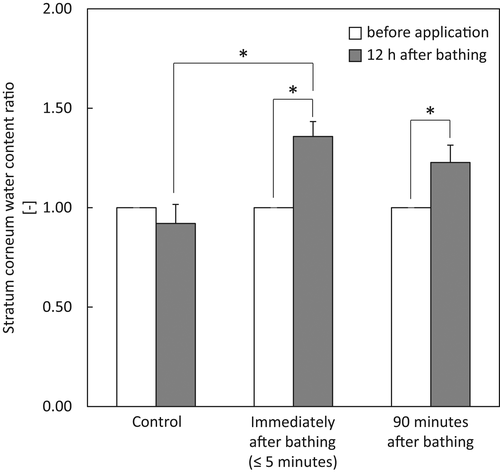
3.1.3 Comparison of the dose per application
The stratum corneum water content ratios at the test sites were compared between different application doses (Figure 2). The water content ratios at sites treated with 0.5 mg/cm2, 1.0 mg/cm2, and 2.0 mg/cm2 of the moisturizer were higher than the water content ratios at the corresponding sites before application. After 12 h from bathing, the stratum corneum water content ratios were higher at the 1.0-mg/cm2 and 2.0-mg/cm2 application sites than at the control site. Furthermore, there were no significant differences in the ratios between the 0.5-mg/cm2, 1.0-mg/cm2, and 2.0-mg/cm2 application sites.
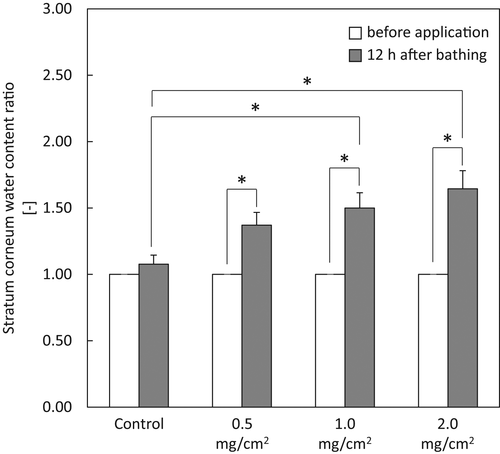
3.1.4 Comparison of the frequency of applications per day
The stratum corneum water content ratios at the test sites were compared between the different application frequencies (Figure 3). The water content ratios at sites treated with a once application (immediately after bathing) and twice applications (immediately after bathing and the next morning) of the moisturizer were higher than the water content ratios at the corresponding sites before application. After 20 h from bathing, the stratum corneum water content ratios were higher at both the once and twice-application sites than at the control site. Furthermore, there were no significant differences in the ratios between the once- and twice-application sites.
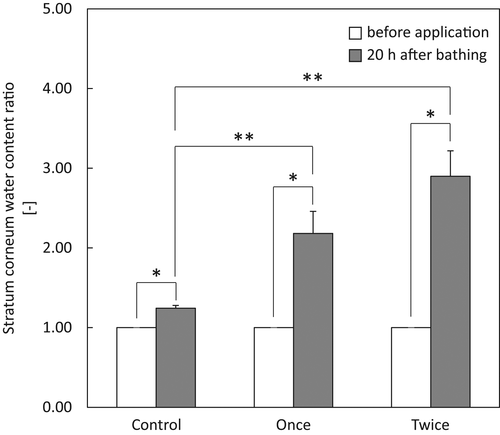
3.2 Experiment 2
3.2.1 Subjects' background characteristics
The mean age of the 24 female subjects was 48 ± 5 years (range: 40–60 years). Among the eight patients with atopic dermatitis, the severity of atopic dermatitis was slight in five cases and mild in three cases according to the diagnostic criteria for atopic dermatitis established by the Japanese Dermatological Association.4
3.2.2 The stratum corneum water content and analyses of the stratum corneum
The stratum corneum water content, stratum corneum trypsin activity, and desmoglein 1 localization score at the baseline and after 8 weeks are shown in Figure 4. Compared to the baseline, the stratum corneum water content significantly increased following a once-daily application (immediately after bathing) and twice-daily application (immediately after bathing and the next morning). Furthermore, compared to the control site, the twice-daily application sites showed a significant increase in the stratum corneum water content after 8 weeks. There were no significant differences in the stratum corneum water content between the once-daily and twice-daily application sites (Figure 4A).
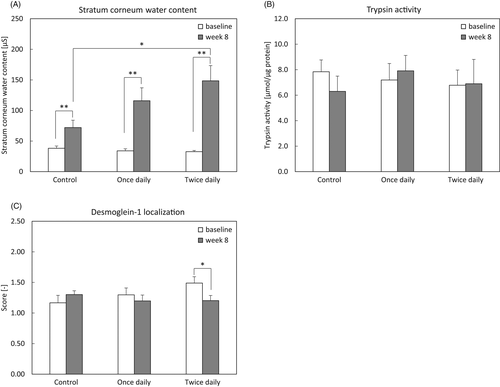
The stratum corneum trypsin activity did not differ significantly between any of the application sites and between the baseline and after 8 weeks. (Figure 4B).
The localization score of desmoglein 1 in the stratum corneum significantly decreased from the baseline to after 8 weeks only in the twice-daily application sites. There were no significant differences between the groups (Figure 4C).
4 DISCUSSION
The present study compared the moisturizing effects of a moisturizer between different application methods with respect to their times, doses, and frequency, and verified the appropriate application method of the moisturizer.
Although the skin surface is moist during bathing, natural moisturizing factors (NMFs) and intercellular lipids can be readily eluted from the stratum corneum. As such, the stratum corneum water content increases rapidly during and immediately after bathing; however, with an increase in the transepidermal water evaporation, it subsequently decreases to the same level as before bathing or even less.15
In the present study, the application of a moisturizer immediately after bathing increased the stratum corneum water content; this suggests that moisturizer application at this timepoint suppresses the evaporation of water from the epidermis and allows moisturizing factors, such as NMFs, to penetrate into the stratum corneum, thereby avoiding dryness. There were no significant differences in the stratum corneum water content between the control sites and the sites treated with 0.5 mg/cm2 of the moisturizer; however, the water content increased significantly with moisturizer doses of 1.0 mg/cm2 and 2.0 mg/cm2. Hence, the appropriate application dose is more than 1.0 mg/cm2 per application, and it is desirable to increase the dose of the moisturizer depending on the degree of skin dryness and preference. Furthermore, there were no differences in the stratum corneum water content between a once-daily application (immediately after bathing at night) and twice-daily applications (immediately after bathing at night and in the morning) in healthy subjects. However, in patients with atopic dermatitis and xeroderma, there was a significant difference in the stratum corneum water content only between the twice-daily application sites and control sites after 8 weeks of application. Therefore, it may be necessary to apply the moisturizer at least twice a day in patients with dry skin.
Desmoglein 1 is a component of desmosomes, which are involved in the adhesion of the stratum corneum cells.16 Desmoglein 1 is distributed in the marginal areas of the keratinocytes of the normal epidermis; however, in patients with atopic dermatitis, it is present throughout the cell, and a correlation with the skin barrier function has been observed using the transepidermal water loss as an index. Furthermore, desmoglein 1 is localized to the marginal areas of the outermost layer of the stratum corneum but is present throughout the stratum corneum cells in the lower layer. Based on these findings, adhesion molecules are thought to be one of the important elements of barrier formation, in addition to the keratinocytes and intercellular lipids that play the roles of the brick and mortar, respectively.14 The water content of the stratum corneum increased with moisturizer application in patients with atopic dermatitis and xerosis, regardless of the number of applications, and the improved effects on skin dryness were higher when the moisturizer was applied twice daily. The localization score of desmoglein 1 was significantly reduced only when the moisturizer was applied twice daily, and short-term moisturizing could result in immediate improvements in the water content of the stratum corneum and dry skin symptoms. However, it was shown that sufficient moisturization was needed to improve skin physiology such as the localization of desmoglein 1 and the skin barrier function. No changes were observed over 8 weeks when the moisturizer was applied once a day, but this frequency of application may be effective if the skin were moisturized continuously over a longer period of time. Because trypsin is an enzyme that degrades desmoglein 1 and is involved in stratum corneum exfoliation,13, 17 the increase in stratum corneum trypsin activity, promotion of desmoglein 1 degradation, and normalization of turnover were postulated to be related to one another. However, there was no significant difference in the stratum corneum trypsin activity between the baseline and after moisturizer application in the present study, suggesting that factors other than trypsin are largely involved in the degradation of desmoglein 1.
The effects of moisturizer application on the stratum corneum condition have rarely been examined in terms of the skin physiology. In this study, it was possible to obtain novel findings on the optimal application method of the moisturizer on the basis of the state of keratinization (determined using the desmoglein 1 localization score in the stratum corneum as an index). The stratum corneum condition and the stratum corneum water content in patients with dry skin, in whom the barrier function of the skin is impaired, are different from those in normal individuals and are known to correlate with the severity of the skin symptoms.12, 18-21 Although it was found that a moisturizing effect could be obtained by applying the moisturizer at dosages higher than 1.0 mg/cm2 twice a day (immediately after bathing at night and in the morning), these findings are more applicable to patients with mild dry skin conditions. Therefore, we would like to further investigate the optimal moisturizer application methods in patients with more severe dry skin conditions, as well as the effects of an optimal dose and frequency of application on the degree of skin dryness and skin condition.
CONFLICT OF INTEREST
Yumi Murakami, Yumiko Saya, and Hiroshi Matsunaka are employees of TOKIWA Pharmaceutical Co., Ltd.
AUTHOR CONTRIBUTION
Conception and design of the study: Yukiko Ueda, and Hiroshi Matsunaka. Recruitment of subjects and acquisition of data: Yukiko Ueda, Yumiko Saya, and Yumi Murakami. Analysis of data: Yukiko Ueda, Yumi Murakami and Yumiko Saya. Drafting of the manuscript: Yukiko Ueda. Revising the manuscript critically for important intellectual content: Hiroshi Matsunaka. All authors reviewed and edited the manuscript and approved the final version of the manuscript.
ETHICAL APPROVAL
This prospective study was approved by the Hattori Clinic Ethics Review Board (Tokyo, Japan) (N027). All study participants provided informed consent to participate in this study.
Open Research
DATA AVAILABILITY STATEMENT
The data that support the findings of this study are available from the corresponding author, upon reasonable request.



